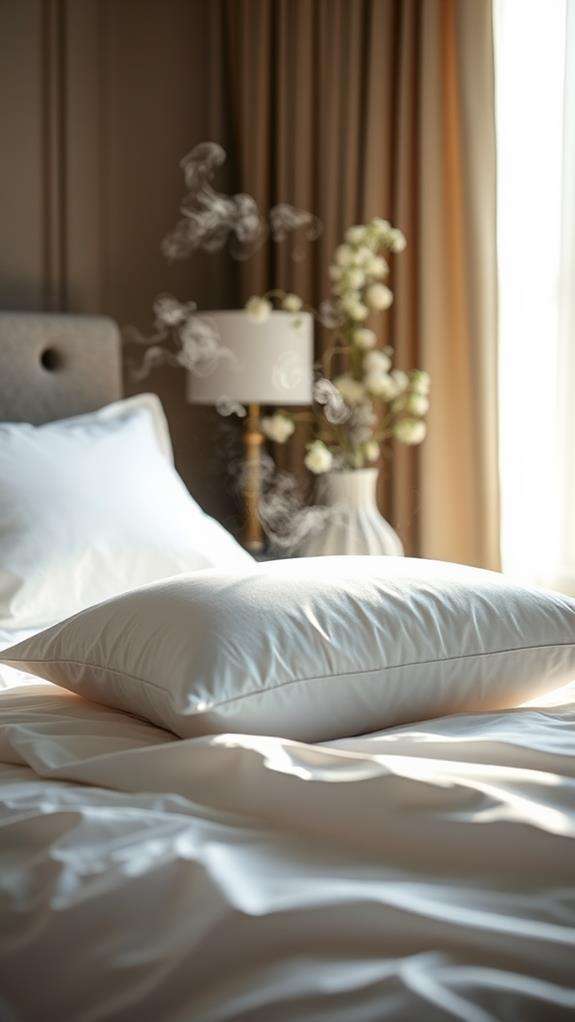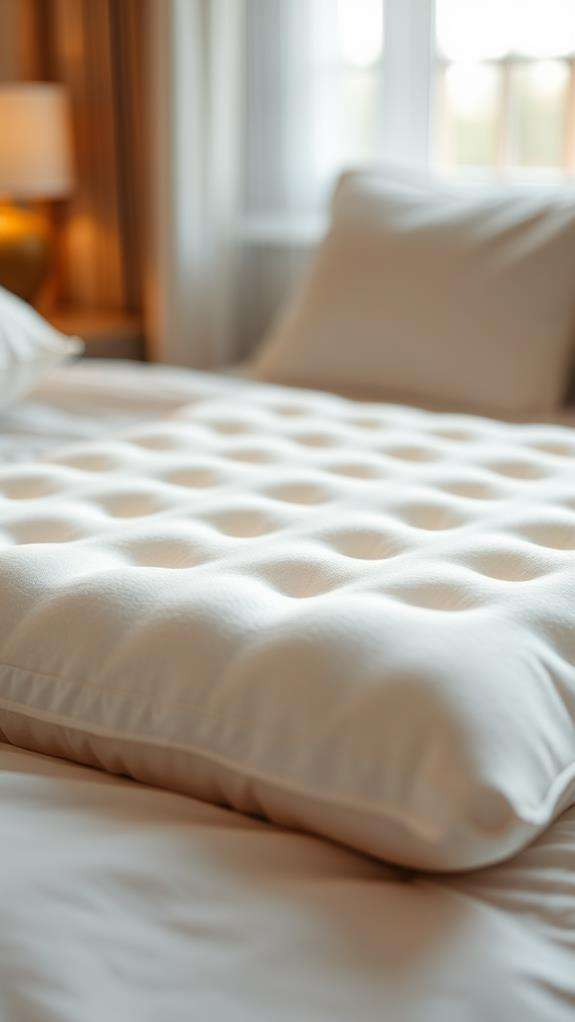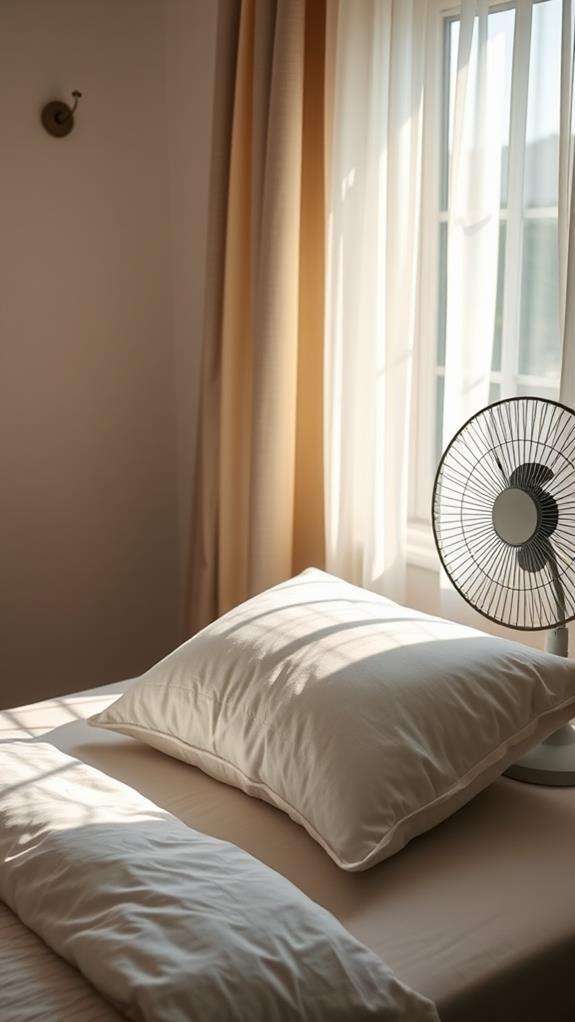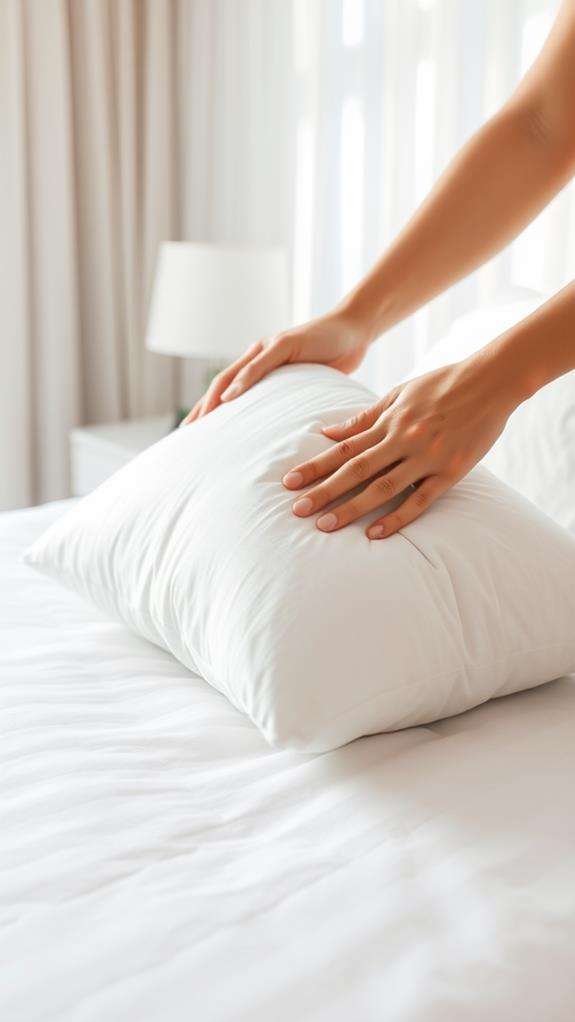How to Break in a New Pillow
Breaking in a new pillow requires patience and proper technique to achieve maximum comfort. You'll need about 5-7 days for complete adaptation, but you can speed up the process using several methods. Try tumble drying on low heat for 15-30 minutes, applying a heating pad for quick softening, or leaving the pillow in direct sunlight for up to an hour per side. Physical manipulation helps too—knead the pillow, apply pressure with your hands, and regularly fluff to redistribute filling. For memory foam pillows, body heat naturally softens the material over time. Maintaining these practices daily will guarantee your pillow reaches its full comfort potential, with more effective techniques awaiting your discovery.
This post may contain affiliate links. If you make a purchase through these links, I may earn a commission at no additional cost to you. Additionally, portions of this post may be generated using artificial intelligence (AI) technology. While we strive for accuracy, please be aware that AI-generated content may not always be perfect and should be fact-checked when necessary.
The Spatula Scoops
- Allow 5-7 days of consistent use to naturally break in the pillow through regular body heat and weight application.
- Tumble dry on low heat for 15-30 minutes or use a heating pad to quicken the softening process.
- Beat, knead, and fluff the pillow regularly to redistribute filling and loosen internal fibers for better comfort.
- Place the pillow in direct sunlight for up to one hour per side to naturally soften without heat damage risk.
- Apply pressure by lying on the pillow or using heavy books for 2-3 minutes to accelerate break-in.
Understanding Your New Pillow

When you first bring home a new pillow, it's important to understand that comfort doesn't always come instantly. Your new pillow may take about five to seven days to reach its ideal comfort level, as it needs time to adapt to your unique body shape and sleeping preferences.
Different pillow materials require varying break-in periods and approaches. Memory foam pillows, for instance, often start quite firm and gradually respond to your body temperature and weight, while down or polyester options typically need less time to soften. To break in a new pillow effectively, you'll want to take into account its specific construction and filling type, as this knowledge will guide your expectations and maintenance routine.
During the acclimating to a new pillow phase, you might experience some initial pain and discomfort, especially if you're shifting from an old, worn-out pillow. This is completely normal, and patience is key. A good pillow will eventually conform to your sleeping position, but you'll need to give it time to soften your pillow naturally. Understanding this adjustment period can help you stay committed to the break-in process and ultimately achieve the comfort level you're seeking.
Heat Methods for Quick Softening

Heat offers a reliable way to expedite your pillow's break-in process, making it more comfortable in a matter of minutes rather than days. Whether you're dealing with memory foam or traditional fill materials, several heating methods can help align your new pillow with your body temperature preferences and sleeping needs.
Here are the most effective heating techniques to soften different types of pillows:
- Place your pillow in a tumble dryer on low heat for 15-30 minutes, which helps break down initial stiffness while maintaining the material's integrity
- Apply a heating pad or electric blanket directly to your pillow for 10-15 minutes, particularly effective for memory foam varieties that respond well to controlled heat
- Position your pillow near a radiator or space heater for about 10 minutes, maintaining a safe distance to guarantee even warming
- Use a hot water bottle method by laying it on top of your pillow for 15 minutes, ideal for both synthetic and down fills
For a natural approach, you can also place your pillow in direct sunlight for up to an hour per side, though you'll want to monitor it carefully to prevent excessive exposure.
Physical Break-In Techniques

A pillow's rigid structure can be quickly transformed through simple physical manipulation techniques. You'll want to start by beating the pillow with your hands or a firm object, which helps redistribute the filling and break down initial stiffness. This technique creates a more even distribution of materials, ensuring better support for your head and neck.
To enhance the break-in process, try applying consistent pressure by lying on the pillow or placing heavy books on top for 2-3 minutes before bedtime. You'll notice the pillow will feel softer and more responsive to your preferred sleeping position. Combine this with regular knocking and fluffing motions to loosen the internal fibers and improve overall comfort.
For ideal results, use a kneading technique similar to working with bread dough. Squeeze and manipulate different sections of the pillow to soften stubborn areas. When you combine these physical methods with heat techniques, you'll accelerate the breaking-in process substantially. Remember to redistribute the filling after each manipulation session by gently shaking the pillow from end to end, ensuring uniform comfort throughout its surface.
Temperature and Environment Control

Temperature control plays a key role in breaking in your new pillow effectively. By manipulating your environment's warmth, you'll find that the material becomes more pliable and responsive to customization. When you're looking to soften your pillow through heat application, it's crucial to maintain safe practices while achieving ideal comfort.
Here's how you can use temperature to enhance your pillow break-in process:
- Adjust your bedroom temperature to create a warmer environment, which naturally helps relax pillow materials and speeds up the softening process
- Position your pillow near a heat source, such as a radiator, maintaining a safe distance for about 10 minutes to encourage material flexibility
- Use controlled heat applications like electric blankets or hot water bottles for 10-15 minutes to break down initial stiffness
- Let your pillow bask in natural sunlight for up to one hour per side, which not only softens but also refreshes the material
Remember that different pillow materials respond uniquely to temperature changes, so you'll want to monitor the softening process carefully. During colder months, maintaining a consistently warm room temperature can greatly improve your pillow's break-in period and overall comfort level.
Daily Practices for Better Comfort

Several daily practices can transform your new pillow from stiff to supremely comfortable. To speed up the break-in period and guarantee a good night's sleep, you'll want to actively use your pillow consistently, allowing your body heat and weight to naturally soften the materials. If you're dealing with memory foam, consider applying a heating pad for 10-15 minutes before bedtime to help the material become more pliable.
Throughout the day, take a few minutes to physically manipulate your pillow by gently kneading, squeezing, or patting it to redistribute the filling. This practice is particularly effective in preventing neck pain and maintaining your preferred sleeping position. Don't forget to protect your investment with a breathable pillowcase, which not only keeps the pillow clean but also provides extra padding during the softening process. For ideal results, maintain this routine for about a week, paying attention to how the pillow responds to your techniques. If you're using it in a slightly warmer room, you'll likely notice faster softening as the material becomes more responsive to your body's contours and pressure points.
Frequently Asked Questions
How Long Does It Take to Adjust to a New Pillow?
You'll typically need 5-7 days to fully adjust to a new pillow, as studies show most people experience improved sleep quality after this initial break-in period. Your adjustment time may vary depending on your pillow's material – memory foam often conforms within minutes of use, while down and polyester fill adapt more gradually. If you keep your bedroom cool, you might need a few extra days, as cold temperatures can slow the pillow's softening process.
Do You Need to Break in New Pillows?
Yes, you'll need to break in new pillows to achieve ideal comfort and support. During the initial 5-30 days, your pillow needs regular use to properly conform to your head shape and sleeping position. This break-in period is especially important for memory foam pillows, which need time to respond to your body temperature and pressure. Don't get discouraged if your pillow feels too firm at first; it's a natural part of the adjustment process.
How Long Does It Take to Air Out a New Pillow?
Just like breaking in your favorite pair of medieval armor, airing out a new pillow takes some patience. You'll typically need 30 minutes to a few hours, depending on your pillow's material. For memory foam pillows, you'll want to allow up to 24 hours due to their density. Place your pillow outdoors in a well-ventilated area, ideally under indirect sunlight, for about an hour per side to eliminate any manufacturing odors effectively.
What to Do With a New Pillow Before Use?
Before using your new pillow, you'll want to check the care label first for specific washing instructions. You can air it out in sunlight for an hour per side to remove manufacturing odors. Try running it through your dryer on low heat for 15-30 minutes to break down stiffness, or use a heating pad for 10-15 minutes. Don't forget to press down on the pillow with some weight to help redistribute the fill material.





